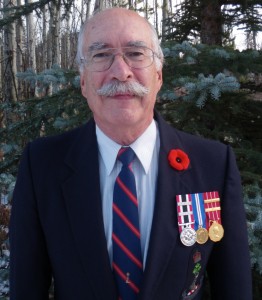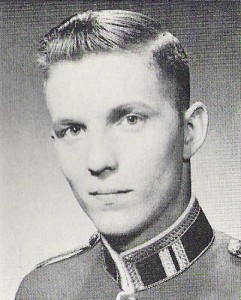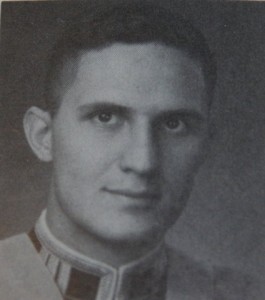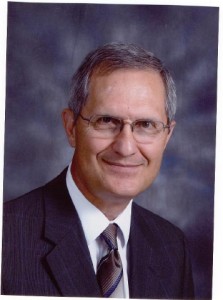
We have contacted numerous ex-cadets from the fifties through to the new millennium and plan to feature them in the coming months to give readers a chance to catch up with names and faces from each of the respective CMCs. If you would like to contribute to this column, please feel free to email me (Ken Eady) at s25247@rmc.ca
– 4135 George W. Hosang (RMC 1958)
After RMC, George went to Portage la Prairie, MB to finish his RCAF flying training on T-33’s. He received his wings, in August, 1958, then obtained his BASc in Mech Eng with honours at U of T in April, 1959.
Next, it was back to Portage for the instrument flying rating and on to #3 AW (F) OTU at Cold
Lake, AB for CF-100 conversion in October, 1959. Then it was off to 425 Alouette Squadron at St. Hubert, QC in April, 1960. What an exhilarating job and existence it was, flying high above the weather and, in those days, most of the other air traffic except the odd DC-8! George’s desire and goal from his youth to fly the CF-100 had been achieved!
In August, 1960 George married Karen Whitney from Sydney, NS, a nurse/stewardess for Trans Canada Airlines, as they were known then.
In April, 1961 CF-100 retirement began with disbandment of 425 Squadron. George was among those transferred to the other CF-100 St. Hubert Squadron, 416 Lynx. It too was disbanded the following August. Still at St. Hubert, the Electronic Warfare Unit there was being greatly expanded with added CF-100’s. Long non-stop trips to the James Bay area and return as “pretend Soviets” supplanted practice intercepts, detachments to Chatham, NB, and air-to-air rocket firing back at Cold Lake. One real EWU highlight was a flight to Frobisher Bay via Goose Bay for the continent-wide Sky Shield II exercise in October, 1961. The return to Montréal at night provided a spectacular show of the Northern Lights.
George was disappointed in early 1962 that the RCAF was not then interested in sponsoring postgraduate studies for aircrew. He obtained an engineering position with Rolls-Royce Canada, RCAF service ending in April. His first assignment was on the Tyne 5300 HP turboprop on Canadair’s CL-44 in service with the RCAF, as the Yukon, and three US freight airlines. After a year or so dealing with all rotating components except the bearings, he was switched to those and all other oil-wetted parts. For those two years, George flew C-45’s and Otters in 401 City of Westmount Reserve Squadron. Then, in late1964, R-R support was offered for a one-year sabbatical for an Athlone Fellowship, providing study at a UK university. The University of Leeds had a 12-month MSc course in friction, wear, lubrication, and bearing technology, the exact field of choice. So, Fellowship won, in September, 1965 Karen and George left for Leeds, their two little girls in tow. They returned to Montréal in December, 1966 with George’s MSc, after a stint at R-R Derby, England.
In June, 1967 George accepted an offer by General Electric’s TF-39 turbofan engine bearings and seals group in Cincinnati, Ohio. Four of these huge engines power the USAF’s C-5 cargo aircraft. He gained responsibility for the eight mainshaft bearings plus the large, highly stressed coupling nuts joining the different sections of the engine’s main shafts.
In September, 1969 George left GE for a contract engineering position with the Pratt and Whitney Aircraft engine bearing and seals group in Hartford, Connecticut.
In September, 1970 he accepted a position at Solar Turbines in San Diego, California. Solar manufactured medium size industrial gas turbines and auxiliary power units (APU’s) for helicopters and small business jet aircraft. George was soon invited to start up a company bearing and seal research and development (R&D) activity. Some projects were water-lubricated journal bearings and seals for turbomachinery, ceramic ball bearings for their small, 93,500 rpm turboalternator, and a test facility for realistic evaluation of turbine blade tip rubbing contact.
Sixteen years later, Solar sold the APU division to Sundstrand and George also moved, retaining both design and R&D responsibilities. He designed long-life high speed ball and roller bearings for a number of new APU’s, including bearings for a new Boeing 737 model and jet aircraft produced by deHavilland Canada/Bombardier. Also, several models of a new, football-sized turbojet engine with speeds over 100,000 rpm were being developed which he found required “hybrid” ball bearings, having ceramic balls. He built an engine simulator facility to test a 130,000 rpm military version. He designed for it a bearing with ceramic races as well as balls, for higher speeds and temperatures, and test housing.
In May, 1994 George started Alouette Technology, a private ball and roller bearing consulting engineering practice. (Name borrowed from 425 Squadron.) Much of his work was local with Solar and, as it is now known, Hamilton-Sundstrand. He also has had clients in the LA area, Southampton, England, Bellevue, WA and Vancouver, BC. A noteworthy first was operation for Sundstrand of the above all-ceramic ball bearings in the simulator with only grease lubrication at 130,000 rpm.
George’s major hobby was singing with the San Diego “Sun Harbor” barbershop chorus. He participated in many local shows and competitions, two international competitions, and a two-week 1990 tour of Germany and Sweden. After the tour, he and Karen continued through France, Germany, Italy, along the French Riviera to the Pyrénées, north to England, and up to Leeds for a sentimental visit. He visited most major Western European bearing manufacturers and Sundstrand’s French engine partner Turboméca. All extended extremely warm welcomes
Since the move to the USA in 1967, George and Karen’s family grew with the addition of two more daughters. Tragically, at Christmas 2004, Karen succumbed to a complex illness. George continues to reside in San Diego. With the exception of Sheryl in England, his family lives close by in southern California.
Can be contacted at ghosang@san.rr.com
__________________________________________
Following graduation from RMC, John began his career as a Flying Officer in the Construction Engineering Branch of the RCAF. Later this Branch became part of the Military Engineering Branch of the Canadian Forces. Early postings included CFB Portage la Prairie, CFS Sioux Lookout and No. 1 Construction Engineering Unit (1 CEU) in Winnipeg. While at 1 CEU he served as site engineer, then project manager for the CF’s project to construct, on behalf of Transport Canada, airstrips at six remote settlements in Canada’s high arctic. In 1969, he returned to RMC to complete his M. Eng. Degree in civil engineering.
In 1972 he was seconded to the Canadian International Development Agency (CIDA) and sent to Indonesia to serve as an advisor to the Indonesian Government’s Airports Authority to advise on airport pavement construction and maintenance operations. During this nine month tour he visited 12 airports, preparing reports on the state of the facilities, and later made recommendations on maintenance strategies and equipment.
Following the last Israeli/Arab conflict in 1974, John was sent to the Golan Heights on the Syrian/Israeli border as the Force Engineer for the United Nations Disengagement Observer Force (UNDOF) to oversee the construction of UN base camps in Syria and Israel. This assignment involved working closely not only with UN personnel, Polish, Austrian and Peruvian soldiers, but contractors and officials on both sides of the border. For this work, he was appointed as an Officer to the Order of Military Merit.
In 1982, following postings to CFB Moose Jaw as Base Construction Engineer, and Maritime Command Headquarters Halifax as the Senior Staff Officer Works, he returned to 1 CEU as Commanding Officer. The principal activity of the Unit at that time was the reconstruction of CFS Alert. His subsequent posting was to Air Command Headquarters as Senior Staff Officer Quartering.
In 1987, as he was being promoted to the rank of colonel, he retired from the CF to take up the position of Assistant Deputy Minister of Engineering and Technical Services with the Manitoba Department of Highways. His responsibilities included providing geotechnical, pavement and traffic engineering services, mechanical equipment support, and managing the operation of 25 provincial airports and six marine vessels, and the provincial fleet of aircraft. Over the years, these responsibilities changed and grew so that in 1999 he became responsible for all provincial highway construction, maintenance and operations activities.
During his years with the Department of Highways he served on a national highway research and development committee and later on the Chief Engineers Council of the Transportation Association of Canada (TAC). He also served for nine years on the U. S. Transportation Research Board’s Long Term Pavement Performance Project management committee which oversaw the multi-million dollar 20 year pavement research program involving both Canada and the U. S. to develop new techniques and products for the construction and maintenance of road pavements. He also served on the Council of the Association of Professional Engineers and Geoscientists of Manitoba (APEGM) and was its president in 2000/2001.
John is living in Winnipeg Manitoba with his wife, Patricia. Both retired 3 ½ years ago. Their daughters Elizabeth and Barbara live in Ottawa and Calgary, respectively, with their families.
Contact: jphosang@shaw.ca.
__________________________________________
– 8401 Robert Cockram (RMC 1971)

A simple brochure at my rural Saskatchewan high school first informed me of the opportunity to experience RMC’s unique athletics program and be paid to “see the world”. Five years of cadet life pursuing that dream produced a BA (Honours History) and a commission as an Artillery lieutenant. Having already completed my phase training I craved some “real soldiering”.
Refresher training at CFB Gagetown delayed my initial regimental service with 2 RCHA at CFB Petawawa until July 1971. I was attached to Q Battery, 5 RALC for Exercise Running Jump II in October 1971. A series of moves over the next decade took me to Edmonton, Lahr (West Germany), Gagetown, and Regina with 1 Airborne Battery (Canadian Airborne Regiment), 1 RCHA, the Training Support Group Battery and W Battery (arisen phoenix-like out of the Training Support Group), and Saskatchewan Militia District. I progressed from battery “gun end” officer 1971/75 to Assistant Adjutant 1975/76 (actually de facto acting Adjutant during the incumbent’s lengthy absences on career courses) to Troop Commander/Administration Officer 1976/77 to Battery Captain (BK) 1977/79.
My extra-regimental service began first as an RSSO 1979/80 then as SO3 Operations and Training 1980/82 including three summers at the NRQ School Shilo as either an instructor or commander for militia Artillery lieutenant and captain qualifying courses. By 1982 I had successfully completed my part-time studies for my MA (Military History) begun at UNB in 1976. My staff employment continued at CFB Shilo as SO3 Operations and Training 1982/83, interrupted by Army Command and Staff College course 8302 and regimental service as 3 RCHA’s Operations Officer, then resuming as SO3 Operations and Training 1984/85 and concluding as Base Adjutant 1985/87.
A move to Victoria as RRMC’s Assistant Registrar 1987/90 enabled me to teach a Canadian (military oriented) history course to 65 second year science/engineering cadets in the fall of 1989. While completing my three year career extension I declined a long term extension offer. My final year with the University Liaison Office Western Area included a May 1991 move to CFB Chilliwack where my retirement leave and transfer to the Supplementary Reserve began six days before the 25th anniversary date of my entry to RMC. My regimental service had included all four RCHA regiments plus two unique RCA batteries.
My quest for adventure while “seeing the world” was realized early on during exercises in locations like Nunavut’s Resolute and Eureka, Vancouver Island’s Toquart Bay, California’s Mojave Desert (including a night parachute jump), and even Manitoba’s Churchill (including a frigid December jump). Fall exercises during 1974/75 involving rapid troop movements over vast expanses of Bavarian countryside provided some dramatic moments of simulated battle. I had missed out on the ultimate adventure of joining the Canadian Airborne Regiment’s reinforcement of UNFICYP during the Turkish invasion of Cyprus in July 1974 but was adequately compensated by joining Operation Dolomite from 18-31 May 1976 as Operations Officer in the Canadian HQ providing humanitarian assistance to Italian earthquake survivors in the Friuli region. Parachuting was always a stimulating activity even at the Combat Training Centre in 1977/78 or the Artillery School on St Barbara’s Day 1982 (my final jump). I visited parts of France, Switzerland, Italy, Austria, Belgium, the Netherlands, Luxembourg, England, and much of West Germany during my NATO service, made Staff College trips to West Germany and Fort Bliss (El Paso), Texas, and took part in the RRMC exchange visit to the U.S. Air Force Academy at Colorado Springs, Colorado. While residing in six provinces and visiting the remainder I also explored much of Canada and travelled on all portions of the Trans Canada Highway from St John’s to Victoria.
RMC’s athletics program during the latter half of “the Major’s” tenure left a lasting influence. Chief Pitt (CPO Reg Pitt) and varsity soccer coach, Sgt Bruce Porter, instilled a philosophy of having fun while keeping physically fit. My team sports participation involved soccer on unit and base teams, recreational hockey at several military locations, and continues with “senior drop-in” hockey at the local arena. I began downhill skiing in 1972, enjoyed brigade ski schools in 1976 and 1985, and now ski locally with my daughter. Participation in endurance events included the 1976 Nijmegen Marches, some German and Dutch “volksmarches”, the 1979 National Capital Marathon, and half marathons in Saskatchewan and Winnipeg. I presided over the Lahr base soccer league in 1975 and coached base soccer teams at Shilo (a 1985 national championship contestant) and Esquimalt, the RRMC soccer team, and youth soccer teams at Shilo and 100 Mile House. In July 2006 I was the second oldest trekker to complete the Canadian Ranger adventure training climb to the summit of Mount McKirdy in the Rockies.
Jeannette and I have been married since June 1988 and resided at Royal Roads before occupying the house I had built on acreage at Lone Butte in British Columbia’s historic Cariboo country. Our daughter, Emma, just turned 15 and is in Grade 9 French Immersion. My military service resumed in March 1993 with a transfer to the Canadian Rangers to help start the 100 Mile House Patrol. After more than a decade as the elected 2IC I now serve as a Ranger. I have been an “on call” substitute teacher assistant and non-certified teacher for the local School District since 1994. In the volunteer sector I spent two years on my former church board and four years on the 100 Mile House Hospital board. Currently my involvement includes ten years on my present church board, twelve years on the Lone Butte Fire Commission, thirteen years on the Lone Butte Historical Association board and three summers of coaching soccer skills at a church sponsored week-long pre-teen soccer camp. Circumstances have allowed me to attend every five year reunion to renew acquaintances with classmates and other ex-cadets while seeing firsthand how RMC has changed yet somehow its traditions continue.
Can be contacted at: rcockram@bcinternet.net
__________________________________________
 17457 Kevin Gaudet (RRMC) has been the federal director for the Canadian Taxpayers Federation since January 2008. Gaudet spent a year(1986-87) studying engineering at Royal Roads Military College in Victoria, B.C., before deciding that was not the path for him. Following his graduation with a degree in philosophy from the University of Lethbridge in 1991, he spent five years as the director of opposition research for Preston Manning. He graduated with an MBA from the Richard Ivey School of Business at the University of Western Ontario in 2000, and worked for various telecommunications, banking, computer and medical technology companies, performing marketing strategy and government relations. In 2007, Gaudet began working as the Ontario director of the Canadian Taxpayers Federation. taxpayer.com He and his wife, Makiko, make their home in Toronto. Kevin has three children. http://www.taxpayer.com/authors/kevin-gaudet
17457 Kevin Gaudet (RRMC) has been the federal director for the Canadian Taxpayers Federation since January 2008. Gaudet spent a year(1986-87) studying engineering at Royal Roads Military College in Victoria, B.C., before deciding that was not the path for him. Following his graduation with a degree in philosophy from the University of Lethbridge in 1991, he spent five years as the director of opposition research for Preston Manning. He graduated with an MBA from the Richard Ivey School of Business at the University of Western Ontario in 2000, and worked for various telecommunications, banking, computer and medical technology companies, performing marketing strategy and government relations. In 2007, Gaudet began working as the Ontario director of the Canadian Taxpayers Federation. taxpayer.com He and his wife, Makiko, make their home in Toronto. Kevin has three children. http://www.taxpayer.com/authors/kevin-gaudet





 – 6913 John Hosang (RMC 1966)
– 6913 John Hosang (RMC 1966)